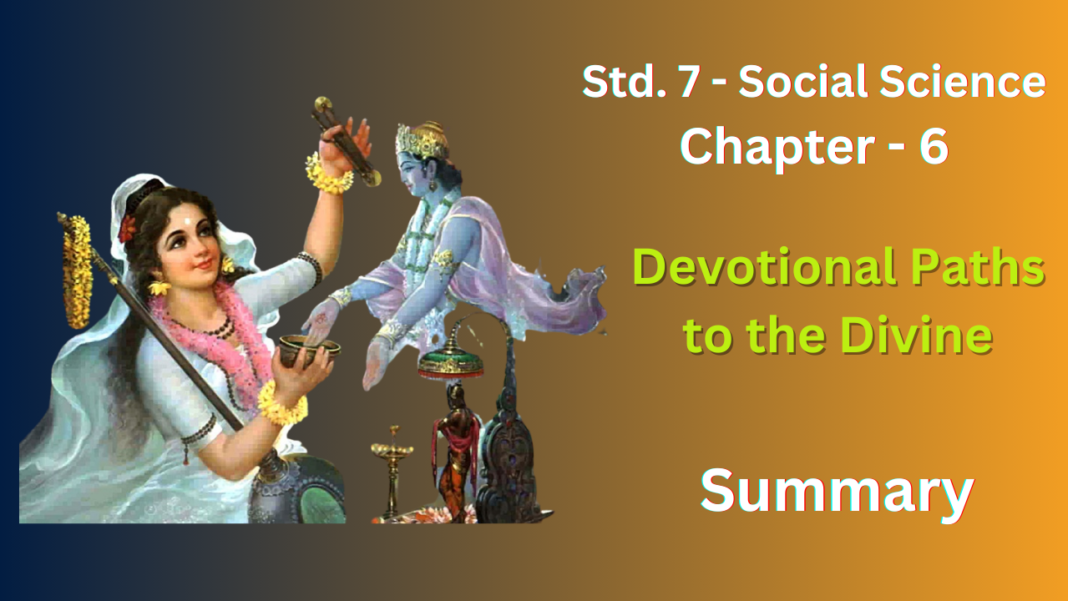NCERT Solutions for Class 7 History Chapter 6
The chapter “Devotional Paths to the Divine” in your 7th-grade social science book explores the diverse ways people in India have expressed their devotion to God or gods throughout history. Here’s a summary:
- Importance of Devotion: The concept of Bhakti (devotion) became a central theme in Indian religions, offering a personal connection with the divine.
- Different Paths: There wasn’t a single way to worship. Various devotional movements emerged, each with its own practices and beliefs.
- Southern Saints (Nayanars and Alvars): Between 7th and 9th centuries, these saints from South India expressed intense devotion to Shiva (Nayanars) or Vishnu (Alvars). They composed devotional poems and songs in local languages, making religion more accessible to common people.
- Nathpanthis, Siddhas, and Yogis: These groups from North India focused on meditation and self-discipline to achieve spiritual liberation. They practiced yoga postures, breathing exercises, and detachment from worldly desires.
- Bhakti Movement’s Impact: These devotional movements helped break down social barriers based on caste. They emphasized the importance of love and devotion for attaining salvation, making religion more inclusive.
- Saints and Gurus: Many devotional movements were led by charismatic saints and gurus who preached through songs, poems, and stories. They played a crucial role in spreading these ideas and inspiring followers.
NCERT Solutions for Class 7 History Chapter 6
Exercises
Let’s Recall
Match the following
| Column I | Column II |
| The Buddha | namghar |
| Shankaradeva | Worship of vishnu |
| Nizamuddin Auliya | Questioned social diffrerences |
| Nayanars | Sufi saint |
| Alvars | Worship of Shiva |
Ans :
| Column I | Column II |
| The Buddha | Questioned social diffrerences |
| Shankaradeva | Worship of Vishnu |
| Nizamuddin Auliya | Sufi saint |
| Nayanars | Worship of Shiva |
| Alvars | Worship of Vishnu |
2. Fill in the blanks:
(a) Shankara was an advocate of…………..
(b) Ramanuja was influenced by the ………….
(c) ……………., ……….. and ………. were advocates of Virashaivism.
(d) ….. was an important centre of the Bhakti tradition in Maharashtra.
Ans :
(a) Advaita.
(b )Alvars.
(c) Basavanna, Allama Prabhu and Akka Mahadevi
(d) Vitthala temple
3. Describe the beliefs and practices of the Nathpanthis, Siddhas, and Yogis.
Ans : The Nathpanthis, Siddhas, and Yogis, although sometimes described separately, all shared core beliefs and practices within Hinduism.
- Focus on Self-Realization: Their primary goal was achieving liberation (moksha) from the cycle of rebirth.
- Renunciation: They believed in renouncing worldly possessions and desires to focus on spiritual pursuits.
- Meditation and Yoga: They practiced intense meditation techniques and yoga postures (asanas) to discipline the mind and body.
- Emphasis on Breathwork: Breathing exercises (pranayama) played a crucial role in their practices, believed to unlock inner energy and enhance focus.
- Rejection of Rituals: Unlike traditional Hinduism, they de-emphasized elaborate rituals and the caste system, focusing on a more direct path to the divine through self-realization.
- Nathpanthis: Founded by Guru Gorakhnath, this group emphasized physical disciplines and yogic postures alongside meditation.
- Siddhas: These were mystical seekers who believed in using alchemy, herbalism, and other practices to achieve spiritual enlightenment.
- Yogis: Broadly, yogis referred to anyone practicing yoga for spiritual growth, with some Nathpanthis and Siddhas also falling under this umbrella.
4. What were the major ideas expressed by Kabir? How did he express these?
Ans : Kabir’s Message in a Nutshell:
Ideas: One God beyond religion, true devotion comes from love, equality for all.
Expression: Simple language, catchy songs (sakhis & pads), relatable stories.
Impact: Influenced Hinduism & Sikhism, message of love & equality lives on.
5. What were the major beliefs and practices of the Sufis?
Ans :
- Mystical Islam: Sufism is a mystical branch of Islam that emphasizes a personal connection with God through love and devotion.
- Focus on Inner Journey: Sufis believe the path to God lies within, achieved through introspection, meditation, and self-purification.
- Love and Devotion (Dhikr): Central to Sufism is Dhikr, the constant remembrance of God through prayer, chanting, and devotional practices.
- Monastic Orders (Sufi Silsilah): Sufis often follow specific lineages (silsilah) led by Sufis saints (pirs) who guide disciples on their spiritual path.
- Asceticism and Austerity: Some Sufis practice a simple and austere lifestyle, detaching themselves from material possessions.
- Music and Poetry (Sama): Sufis use devotional music (sama) and poetry to express their love for God and induce spiritual ecstasy. (Note: This practice is debated within Islam)
- Unity of Existence: Some Sufi mystics believe in the concept of Wahdat al-Wujud (“unity of being”), suggesting all creation is a manifestation of the divine.
6. Why do you think many teachers rejected prevalent religious beliefs and practices?
Ans :
- Social Justice: Opposed caste systems and inequality.
- Simpler Practices: Favored personal connection over rituals.
- Science vs. Religion: Questioned beliefs conflicting with science.
- Focus on Devotion: Emphasized love for God over strict rules.
- Universal Truths: Sought messages for everyone, not just one religion.
- Reformers: Wanted to modernize religious practices and teachings.
7. What were the major teachings of Baba Guru Nanak?
Ans :
- One God (Waheguru): Everyone worships the same universal God.
- Equality for All: Forget caste, everyone is equal.
- Live Honestly, Serve Others: Work hard, help others without expecting anything back.
- Connect with God: Remember God through prayer and meditation.
- Community & Equality: Share meals together (Langar) regardless of background.
- Five Ks: Sikhs wear these articles of faith for spiritual commitment.
8. For either the Virashaivas or the saints of Maharashtra, discuss their attitude towards caste.
Ans : The Virashaivas rejected the caste system. They believed everyone is equal before God, with devotion (Bhakti) being the key, not your birth. Their movement welcomed all and transcended caste through practices like Lingayatism. They challenged the status quo and inspired social reform.
9. Why do you think ordinary people preserved the memory of Mirabai?
Ans :
- Rebel Princess: Defied expectations, resonated with those feeling constrained.
- Simple Language: Bhajans in local language made Krishna accessible to all.
- Unwavering Faith: Inspired with her strength and devotion to Krishna.
- Emotional Connection: People connected with her love and longing for Krishna.
- Oral Tradition: Songs kept her memory and message alive.
NCERT Solutions for Class 7 History Chapter 6
FAQ’s
What is covered in Class 7 History Chapter 6, focusing on “Devotional Paths to the Divine”?
Class 7 History Chapter 6 delves into the exploration of various devotional paths that lead individuals to the divine, highlighting the significance of bhakti and sufi movements in ancient India.
How do NCERT Solutions for Class 7 History Chapter 6 enhance understanding of “Devotional Paths to the Divine”?
NCERT Solutions for Class 7 History Chapter 6 provide comprehensive insights into the bhakti and sufi movements, elucidating their impact on religious practices and beliefs during ancient times.
Can Class 7 History Chapter 6 shed light on the origins and principles of bhakti and sufi movements?
Yes, Class 7 History Chapter 6 explores the origins, principles, and ideologies of bhakti and sufi movements, offering historical context and narratives to deepen understanding.
How did the bhakti and sufi movements contribute to the cultural and social fabric of ancient India, as discussed in Class 7 History Chapter 6?
Class 7 History Chapter 6 discusses the profound influence of the bhakti and sufi movements on shaping cultural expressions, social inclusivity, and religious pluralism in ancient India.
What are some key figures and practices associated with the devotional paths explored in Class 7 History Chapter 6?
Class 7 History Chapter 6 introduces students to prominent figures such as Kabir, Mirabai, and Ravidas, along with their teachings and practices that epitomize the essence of bhakti and sufi traditions.









